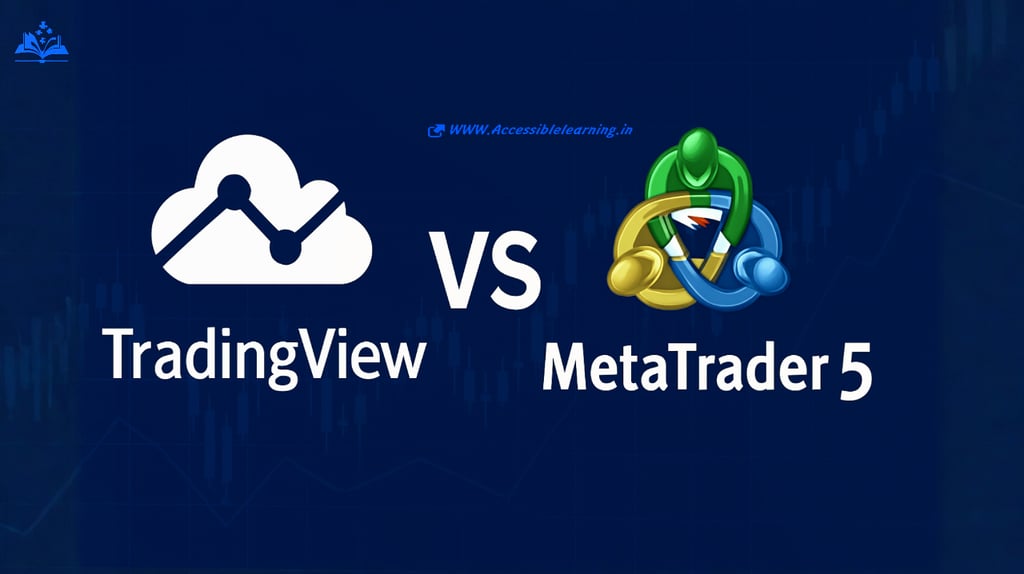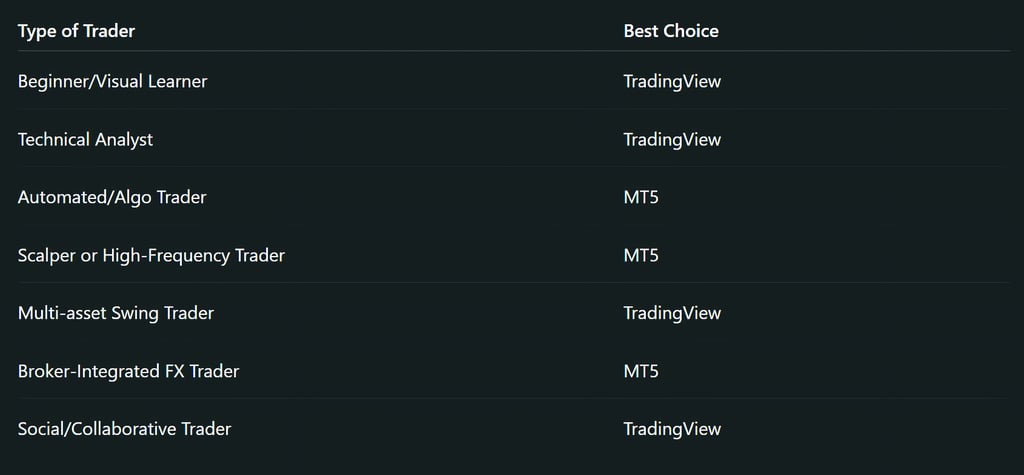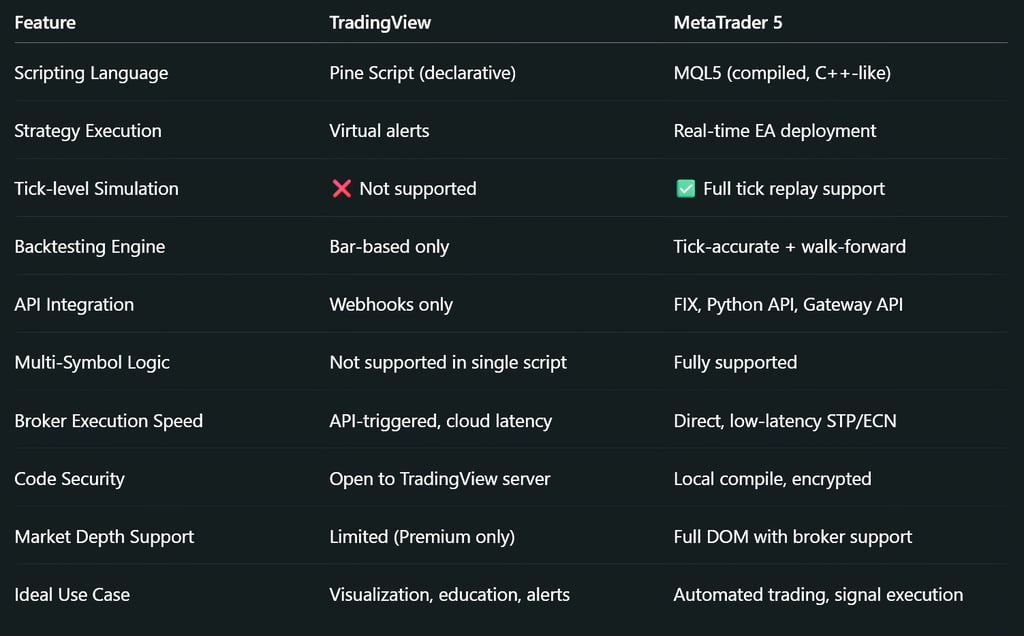
TradingView vs MetaTrader 5 (MT5): Which Trading Platform Is Best for You?
Discover the key differences between TradingView and MetaTrader 5, from charting tools and scripting capabilities to broker integration, automation, latency, and backtesting. A complete guide for beginners, technical traders, and algorithmic developers.
AI ASSISTANTA LEARNINGSTOCK MARKETSTOCK OPERATOREDITOR/TOOLS
Sachin K Chaurasiya
8/13/20255 min read


When it comes to online trading, selecting the right platform can dramatically shape your success. Two of the most recognized names in the market today are TradingView and MetaTrader 5 (MT5)—but they serve very different purposes.
Whether you're a beginner seeking intuitive charts or a seasoned trader looking for robust automation, this article breaks down the core differences, latest features, and real-world usability of TradingView vs MT5, helping you choose the best tool for your trading goals.
What Is TradingView?
TradingView is a web-based charting and analysis platform designed for traders and investors who prioritize technical analysis, visualization, and social interaction. With a vast community of users, Pine Script customization, and access to global market data, TradingView has become the go-to for both beginners and technical pros.
Key Features
Interactive, modern charts with real-time data
Over 100 built-in indicators + 100,000+ community-created scripts
Pine Script editor for custom strategies
Social network: publish and follow trade ideas
Supports crypto, stocks, forex, indices, and more
Web-based (no installation), with mobile and desktop versions
What Is MetaTrader 5 (MT5)?
MetaTrader 5, the successor to MT4, is a multi-asset trading platform developed by MetaQuotes. It offers professional-grade tools for automated trading (via Expert Advisors), direct broker integration, and detailed market execution features.
Key Features
Advanced order management and trade execution
Native support for algorithmic trading (EAs written in MQL5)
Multi-threaded strategy tester for backtesting
Economic calendar and news integration
Supports forex, stocks, commodities, and futures (depending on broker)
Desktop-first software with mobile versions
Core Differences: TradingView vs MT5
Let’s explore how these platforms compare across essential aspects:
User Interface & Accessibility
TradingView offers a clean, modern UI with drag-and-drop elements, cloud-based access from any device, and no installation required. It’s ideal for beginners.
MT5 uses a traditional trading terminal design. While powerful, it can be intimidating for new users due to its dense interface and broker-dependent setup.
Winner for UX: TradingView
Charting & Technical Analysis
TradingView is known for its best-in-class charting: multiple timeframes, replay mode, multiple chart layouts, and advanced drawing tools.
MT5 includes up to 38 built-in indicators and custom indicator support, but the visual and interactive experience lags behind TradingView.
Winner for charting: TradingView
Automation & Algorithmic Trading
TradingView supports basic strategy scripts and alerts but lacks native automated trading. Execution requires third-party bridging tools (e.g., webhook integrations).
MT5 is built for automation. You can create, test, and deploy algorithmic strategies (EAs) using MQL5, with native backtesting and optimization tools.
Winner for automation: MetaTrader 5
Community & Learning
TradingView shines with a collaborative environment where users can share trade ideas, publish charts, and learn from peers. It’s built for social trading.
MT5 focuses on execution and doesn’t include social features. Learning happens outside the platform via forums or paid courses.
Winner for community: TradingView
Broker Integration & Execution
TradingView connects to a limited set of brokers (like OANDA, FXCM, or TradeStation) depending on your region.
MT5 is supported by a wide array of global brokers, especially in forex and CFD markets. It offers fast execution, order routing, and advanced order types.
Winner for execution: MetaTrader 5
Cost & Pricing
TradingView offers a free plan with limitations and several paid tiers (Pro, Pro+, and Premium) ranging from $15 to $60/month, offering more indicators, alerts, and layouts.
MT5 is free to use, but broker commissions, spreads, and overnight fees apply. There are no direct subscription fees for using the platform.
Winner for affordability: Tie (depends on broker vs subscription)




Scripting Architecture: Pine Script vs MQL5
TradingView – Pine Script (v5)
Type: Declarative, event-based scripting language
Use Case: Primarily for creating custom indicators, overlays, strategy testing with alert conditions
Limitations:
No native support for trade execution
Doesn’t support OOP or asynchronous processes
Limited ability to reference external datasets (no file I/O or API calls)
MetaTrader 5 – MQL5
Type: Procedural, C++-like, object-oriented language
Use Case: Designed for building Expert Advisors (EAs), indicators, trading panels, and DLL extensions
Strengths:
Full automation with broker execution
Supports file operations, HTTP requests, DLL interfacing
Granular control over tick-based strategies
Strategy Testing and Optimization
MetaTrader 5
Multi-threaded strategy tester supporting:
Genetic optimization algorithms
Forward testing
Real tick data with modeling quality up to 99%
Parameter iteration and walk-forward analysis
Backtesting Modes:
Every tick, 1-minute OHLC, and real tick
Custom Metrics: Drawdown, recovery factor, Sharpe ratio, expectancy, etc.
TradingView
Basic in-chart strategy tester:
Supports bar replay for visual analysis
Limited performance metrics (net profit, drawdown, win rate)
Lacks real market modeling or slippage control
No portfolio-level testing or optimization tools
Execution Engines & Order Handling
MetaTrader 5
Natively supports:
Market, limit, stop, stop-limit, trailing stops
Partial fills, fill-or-kill, IOC (Immediate or Cancel)
Execution Modes:
Exchange execution (for stocks/futures)
Market execution (for forex/CFDs)
Depth of Market (DOM): Real-time level 2 pricing via broker feeds
TradingView
Webhooks and alerts trigger external order execution
No direct order routing engine; depends on:
Broker plug-ins (e.g., Alpaca, Tradovate)
Middleware like MetaConnector or AutoView
Risk: Increased latency, third-party dependency, error-handling constraints
Market Data & Latency Control
TradingView
Aggregated market data from multiple exchanges and sources (e.g., Cboe, CME, Binance)
Data is delayed unless user subscribes to real-time feeds
Server-side rendering latency: ~100–400 ms depending on region and load
Data normalization can cause slippage when backtesting live-executed strategies
MetaTrader 5
Market data is broker-supplied with optional FIX protocol compatibility
Broker-determined latency often sub‑50 ms in optimized VPS setups
Tick-level accuracy and real-time feed syncing with ECN providers (e.g., LMAX, IC Markets)
Custom Indicators & Marketplace
TradingView
100,000+ indicators on the public script library
Pine Script’s simplicity means fast prototyping
Limited access to source code in “invite-only” scripts
No local storage or batch scripting allowed
MetaTrader 5
Vast MQL5 Marketplace for:
Indicators
Signals
Trading panels and EAs
Source code available in many cases; full customization possible
Paid licensing options with DRM and anti-piracy tools

Security, Platform Control & Hosting
TradingView
Hosted on cloud-based architecture, user data stored remotely
Limited sandboxed control over sessions
Custom scripts are run server-side; users have no backend access
No VPS or local control unless bridged
MetaTrader 5
Supports local installation, dedicated trading VPS hosting, or cloud sync
Full encryption of EA logic
Supports SSL/TLS protocols and broker-side protection
Ideal for regulatory compliance, data sovereignty, and institutional integration
In 2025, the choice between TradingView and MT5 is less about which is better overall and more about which fits your trading goals.
Choose TradingView if you're focused on analysis, charts, or learning from others.
Choose MetaTrader 5 if you're ready for serious trading execution and automation.
Want the best of both? Use TradingView to analyze and MetaTrader 5 to automate and execute.
FAQs
Q. Can you trade directly on TradingView?
Yes, but only with supported brokers. Execution is limited compared to MT5’s native broker integration.
Q. Is MetaTrader 5 suitable for stock trading?
Yes, MT5 supports stocks and other assets, but availability depends on the broker you use.
Q. Is Pine Script easier than MQL5?
Yes, Pine Script is easier and beginner-friendly. MQL5 is more powerful but has a steeper learning curve.
Q. Can I use both TradingView and MT5 together?
Yes! Many traders analyze with TradingView and execute trades in MT5, combining the best of both worlds.
Subscribe To Our Newsletter
All © Copyright reserved by Accessible-Learning Hub
| Terms & Conditions
Knowledge is power. Learn with Us. 📚


